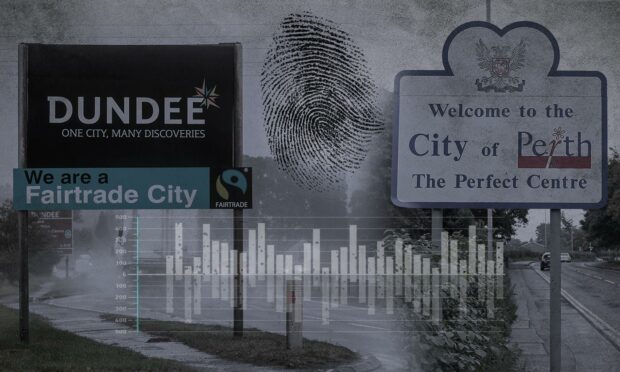Dundee has the highest crime rate in Scotland, despite offences nationally dropping to among the lowest rates in decades.
The city now has the highest crime rate in Scotland, overtaking Glasgow, while Perth sees the third-highest increase in the country.
A report by the Scottish Government shows the total number of crimes recorded by Police Scotland in the past year was 246,511 – among the lowest levels since 1974.
In the last 10 years, Scotland’s overall crime rates have decreased by 22%, while Dundee’s crime rates have increased by 4%.
It is one of only three local authorities in Scotland to see a rise in the last decade, along with East Lothian and Dumfries and Galloway.
Rates in Perth and Kinross, Angus and Fife have all decreased over the last ten years.
Perth crime rate third highest increase
Despite the crime rate in Perthshire dropping in the last 10 years – it spiked by 11% compared to last year – the third highest increase out of any local authority.
Crime rates in Dundee and Angus both increased by 8% compared to 2019/2020, while Fife’s had increased 3%.
Overall, Scotland’s crime rates had neither increased or decreased in comparison to last year.
Dundee crime rate ranked worst in Scotland
In the report, Dundee was ranked the worst in Scotland for crime as the city’s total number of recorded crimes per 10,000 population was 688, while Scotland’s average is 451.
Crime rate in Scotland by area
Fife was 19th on the list with 380 per 10,000 while Perth & Kinross followed closely behind at 21st with 320 and Angus sat at 25th with 293.
Crime solving rates
The report showed that Scotland’s clear up rate – which measures the percentage of recorded crimes which have been solved – in 2020-21 was 56.3%, the highest since comparable records began in 1976.
It was also up 4.8% from 51.5% in 2019-20.
The statistics revealed Tayside has below average crime solving rates as Dundee has 55.8%, Angus has 55.1% and Perth and Kinross has 55.7%.
Fife’s average crime solving rates were however were below average with 63%.
Decrease in crimes in Scotland
Between 2019-20 and 2020-21, recorded crime fell under four key areas: non-sexual crimes of violence, sexual crimes, crimes of dishonesty, and fire raising and vandalism.
Non-sexual crimes of violence had decreased by 4% in Scotland from 9,316 to 8,972.
1,641 of non-sexual crimes of violence fell under the Domestic Abuse (Scotland) Act 2018, the second year this legislation has been in place.
This year, Dundee was also named the worst in Scotland for domestic abuse as cases in Scotland rose for the fourth year.
Sexual crimes have decreased this year by 2% from 13,364 to 13,131 and crimes of dishonestly have dropped by 19% from 111,409 to 89,731, which is the lowest level since 1971.
Fire-raising and vandalism have also decreased from the previous year by 10% from 47,731 to 42,964 – the lowest level seen since 1975.
Cyber-crime on the rise
The figures also show cyber-crimes are on the rise as rates have almost doubled from last years figures.
There was a year-on-year rise of 149% for online fraud, and a 152% rise in digital threats and extortion.
The report suggests this increase may be due to the impacts of the coronavirus pandemic, including behavioural changes such as increased online shopping.
Scottish Conservative shadow cabinet secretary for justice, Jamie Greene MSP, called for tougher sentences for cyber criminals.
He said: “These annual figures make for shocking reading.
“Vulnerable people across Scotland are being ripped off and left devastated by fraudsters.
“That is exactly why we want criminals who commit such heartless acts to receive tougher sentences.
“The SNP Government’s soft-touch approach is letting down vulnerable people, which is why we are proposing a Victims Law to put victims of crime at the heart of the justice system.”
‘Still work to be done’
Justice secretary Keith Brown said: “By all main measures crime, including violent crime, is now considerably lower than it was a decade ago, with fewer victims.
“These statistics show how crime in areas like vandalism and dishonesty, the sorts of crime that affects peoples’ everyday lives, has fallen – with levels not seen since the 1970s.
“There is still work to be done as the figures on cybercrime show – which is why we have this year published a prevention, awareness and enforcement strategy to make Scotland an inhospitable place for scammers.
“Overall, these very positive trends are testimony not just to the hard work of Police Scotland but to the vital support the Scottish Government has put in place to enable officers to do their jobs effectively.”


